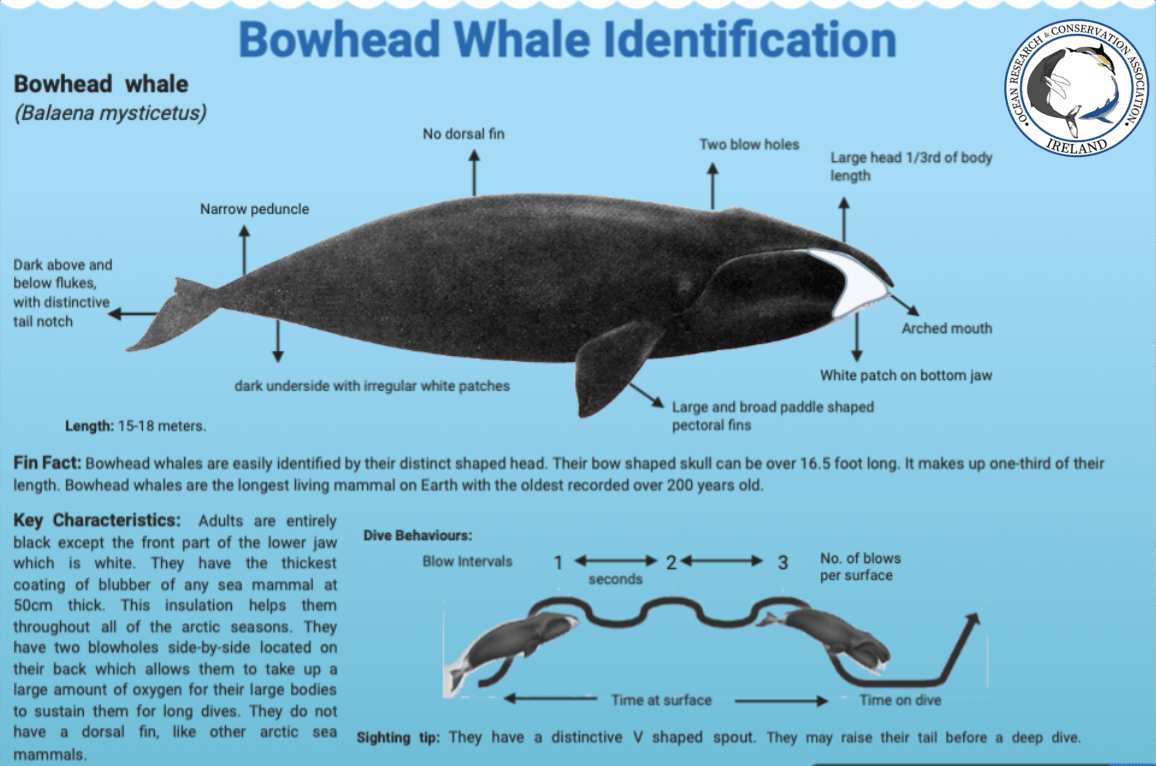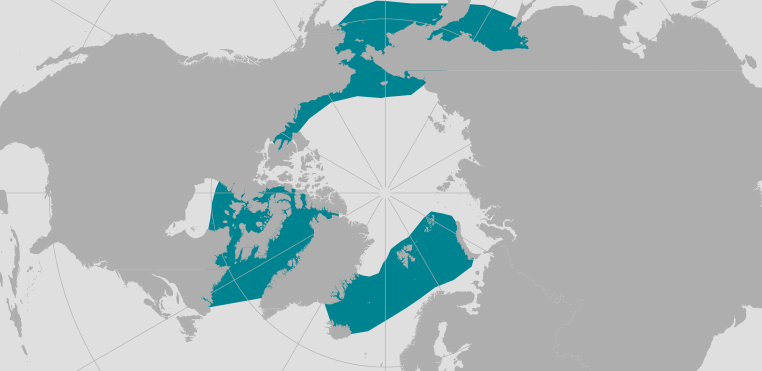Bowhead Whale
(Balaena mysticetus)
Classification:
Kingdom: Animalia
Phylum: Chordata
Class: Mammalia
Order: Artiodactyla
Infraorder: Cetacea
Family: Balaenidae
Genus: Balaena
Species: B. mysticetus
Get the facts:
Bowhead whales are marine mammals belonging to the suborder Mysticete also known as baleen whales. They are classified due to the presence of baleen plates in their jaws which allow them to filter feed. They are the longest living mammals in existence.
Species identification:
Bowhead whales are easily identified by their distinct shaped head. Their bow shaped skull can be over 16.5 foot long. It makes up one-third of their length. They have an average length of 15-18 m but have been reported at 20m and can weight up to 100 tonnes. Adults are entirely black except the front part of the lower jaw which is white. They have the thickest coating of blubber of any sea mammal at 50cm thick. This insulation helps them throughout all of the arctic seasons. They have two blowholes side-by-side located on their back which allows them to take up a large amount of oxygen for their large bodies to sustain them for long dives. They do not have a dorsal fin, like other arctic sea mammals. This benefits them as it helps to prevent heat loss and reduces surface area, it also allows them to swim under ice sheets.
Diet:
Bowhead whales feed by swimming with their mouths open. They filter food through keratin bristles known as baleen plates. They feed almost exclusively on marine invertebrates such as krill and copepods. They often ingest other invertebrates and small fish. They can eat up to 2 tonnes of food every day and annually need to consume up to 100 tonnes of food to survive. The majority of their feeding takes place during the summer in the Canadian arctic.
Habitat:
They are found in the Northern hemisphere in Arctic and subarctic waters, around pack ice and often in shallow water. In June 2016, a juvenile bowhead whale was spotted in Carlingford Lough, by Carlingford Lough Pilots. This was the first record of a bowhead whale in Irish waters, bringing the total number of cetaceans sighted here to 25 species.
Behaviour:
Bowheads are often observed using their large skulls to break ice. They can break ice up to 60cm thick. They often have scars on their bodies from doing this. They can also breach their entire bodies out of the water.
Social structure:
Bowheads can be seen on their own or in small pods. They are known for their intense social group interactions. These interactions include breaching, tail, and flipper slapping.
Reproduction:
Bowheads reach sexual maturity at approximately 25 years old, when their body length is 35-45 feet. Mating behaviour can be observed all year round, however, most conceptions are believed to occur during late winter or spring. Females have one calf every 3-4 years after a gestation period of 13-14 months. Most of the calves are born between April and early June during spring migration. They are usually about 13 feet long weighting roughly 200 pounds and can swim at birth. They form a very close attachment to their mothers.
Vocalisations:
Bowhead whales are highly vocal and use a large variety of calls. Sound is critical to their survival as the echoes allows them to detect, recognise and localise biologically important sounds for navigation, predator avoidance, foraging and communication in the marine environment. Based on their anatomy and vocalisations of others closely related to them, they hear best at low frequencies. Low frequency sounds are capable of travelling greater distances and may allow for long range communication.
Lifespan:
They are the longest living mammal in existence and maybe even the longest living animal on Earth. They can live from 100 to over 200 years old.
Global distribution:
Bowhead whales are predominantly an arctic species associated with ice floes. Their movement is influenced by melting and freezing ice. They spend winter near the southern limit of the pack ice and move north as the sea ice breaks up and recedes during the spring. They are one of the few whale species that are almost exclusively found in the arctic and subarctic waters.
Stocks of bowheads occur around the world, and four stocks are recognised by the International Whaling Commission (IWC). Smalls stocks of a few hundred individuals occur in the Okhotsk Sea. There is only one stock in US waters, the Western Arctic stock. Stocks from western Greenland and Eastern Canada are now considered one stock thanks to genetic analysis.
Population status:
Bowhead whales are listed as endangered in USA under the Endangered Species Conservation Act since 1970 and the Endangered Species Act in 1973. They are also listed as depleted under the Marine Mammal Protection Act. The population of bowhead whales were a lot higher before whaling occurred. It is believed they were once at a minimum of 50,000 individuals. The Western Arctic stock which was once estimated between 10,400-23,000 individuals was driven down to less than 3000 individuals. They have recovered well since the early 1900s and are now the largest population of bowheads worldwide. Other stocks have not been so lucky, such as the Okhotsk stock which still remain dangerously low at only a few hundred individuals. The worldwide population is now believed to be more than 16,000.
Threats to survival:
Bowhead whales are currently listed as least concern, however, there is always threats to their survival. This can be seen in the Greenland population, who are endangered. They are traditionally hunted by commercial whales until the last century for oil, meat, and baleen. Native communities in the U.S. and Russia hunted them for subsistence purposes. This subsistence whaling is approved, and its sustainability is ensured by the International Whaling Commission (IWC). Some populations are faring out better than others as a result of the IWC commercial whaling moratorium. They are threatened by habitat loss, toxic waters, and climate change, along with offshore oil and gas exploration and increased shipping in Arctic waters. Increased shipping can lead to vessel strikes, ocean noise and contamination on the water. There is also a risk they will get caught in fishing gear.






